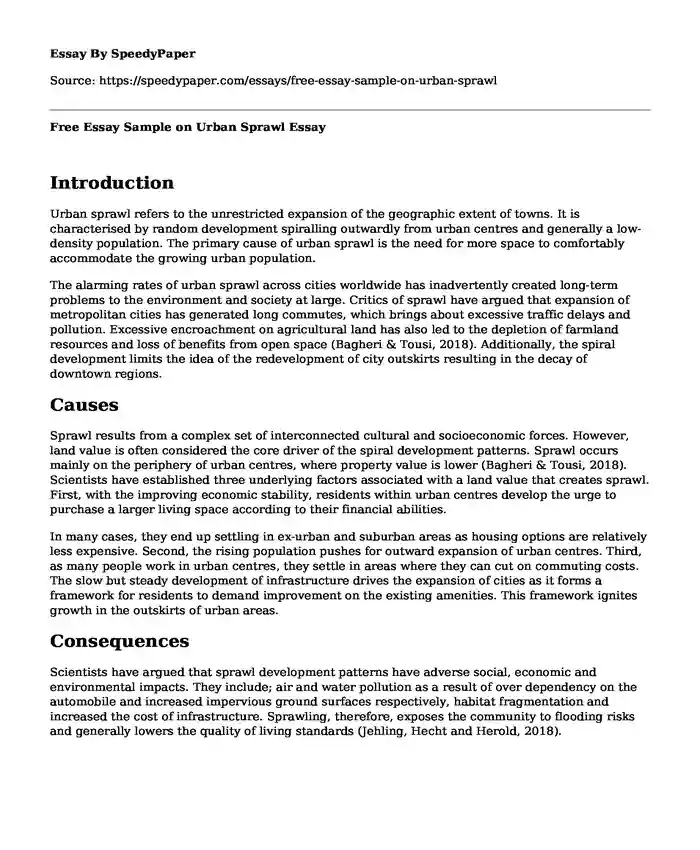Introduction
Urban sprawl refers to the unrestricted expansion of the geographic extent of towns. It is characterised by random development spiralling outwardly from urban centres and generally a low-density population. The primary cause of urban sprawl is the need for more space to comfortably accommodate the growing urban population.
The alarming rates of urban sprawl across cities worldwide has inadvertently created long-term problems to the environment and society at large. Critics of sprawl have argued that expansion of metropolitan cities has generated long commutes, which brings about excessive traffic delays and pollution. Excessive encroachment on agricultural land has also led to the depletion of farmland resources and loss of benefits from open space (Bagheri & Tousi, 2018). Additionally, the spiral development limits the idea of the redevelopment of city outskirts resulting in the decay of downtown regions.
Causes
Sprawl results from a complex set of interconnected cultural and socioeconomic forces. However, land value is often considered the core driver of the spiral development patterns. Sprawl occurs mainly on the periphery of urban centres, where property value is lower (Bagheri & Tousi, 2018). Scientists have established three underlying factors associated with a land value that creates sprawl. First, with the improving economic stability, residents within urban centres develop the urge to purchase a larger living space according to their financial abilities.
In many cases, they end up settling in ex-urban and suburban areas as housing options are relatively less expensive. Second, the rising population pushes for outward expansion of urban centres. Third, as many people work in urban centres, they settle in areas where they can cut on commuting costs. The slow but steady development of infrastructure drives the expansion of cities as it forms a framework for residents to demand improvement on the existing amenities. This framework ignites growth in the outskirts of urban areas.
Consequences
Scientists have argued that sprawl development patterns have adverse social, economic and environmental impacts. They include; air and water pollution as a result of over dependency on the automobile and increased impervious ground surfaces respectively, habitat fragmentation and increased the cost of infrastructure. Sprawling, therefore, exposes the community to flooding risks and generally lowers the quality of living standards (Jehling, Hecht and Herold, 2018).
Sprawl Reduction Policies
Although the causes and effects of sprawl are quite discouraging, procedures can be established to control the unsustainable growth patterns. Planning policies can help local communities to develop an ecologically sustainable and intended spatial design on land use. Compact development policies can help in restricting population growth within a particular region hence controlling sprawling into rural areas (Jehling, Hecht and Herold, 2018).
Policymakers can also select and implement specific sprawl reduction policies. For instance, fragmentation regulations, land development prescriptions, urban growth boundaries and building permit limits can limit growth to the desired locations only. Incentive-based techniques can also be employed, such as developing density bonuses and house clustering to encourage the containment of development to regions within the city centres. Moreover, infrastructure-based policies such as; phasing of development, targeted public investments and land purchasing procedures can enable governments to acquire and secure areas that are ecologically critical (Jehling, Hecht and Herold, 2018). Additionally, educating the public on the adverse effects of sprawl can be paramount in the campaign.
Conclusion
Overall, these policies can help in sprawl control without any compromise to the required sustainable development. Proper urban planning can result in reduced costs of infrastructure, cleaner resources: water and air, protected natural systems and improved quality of life.
References
Bagheri, B., & Tousi, S. N., (2018). An explanation of the urban sprawl phenomenon in Shiraz Metropolitan Area (SMA). Cities, 73, 71-90.
Jehling, M., Hecht, R., & Herold, H. (2018). Assessing urban containment policies within a suburban context; an approach to enable a regional perspective. Land use policy, 77, 846-858.
Cite this page
Free Essay Sample on Urban Sprawl. (2023, Jan 08). Retrieved from https://speedypaper.com/essays/free-essay-sample-on-urban-sprawl
Request Removal
If you are the original author of this essay and no longer wish to have it published on the SpeedyPaper website, please click below to request its removal:
- Free Essay on Education and Cultural Change
- Law Essay Sample: Theft Analysis In Criminology Theories
- Annotated Bibliography Example on American Constitution
- Essay Sample on Workplace Ethics and Values
- Essay Sample on Malpractice Insurance
- Free Essay Example: Importation of Slavery
- Examining Drug and Substance Abuse as a Social Problem: Essay Sample
Popular categories





